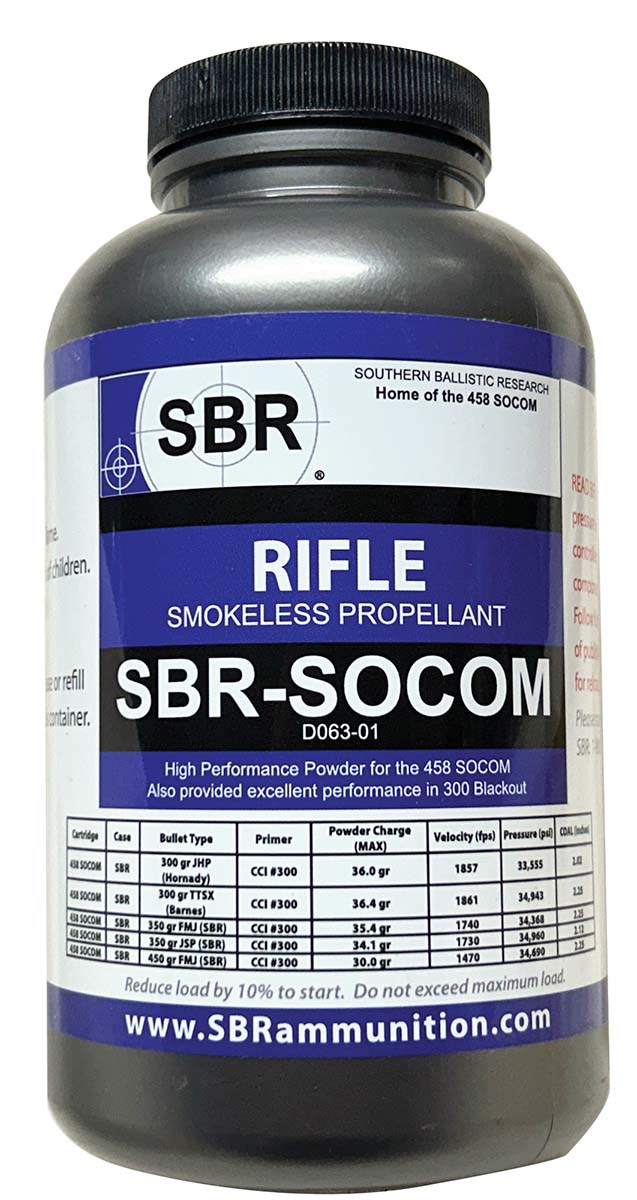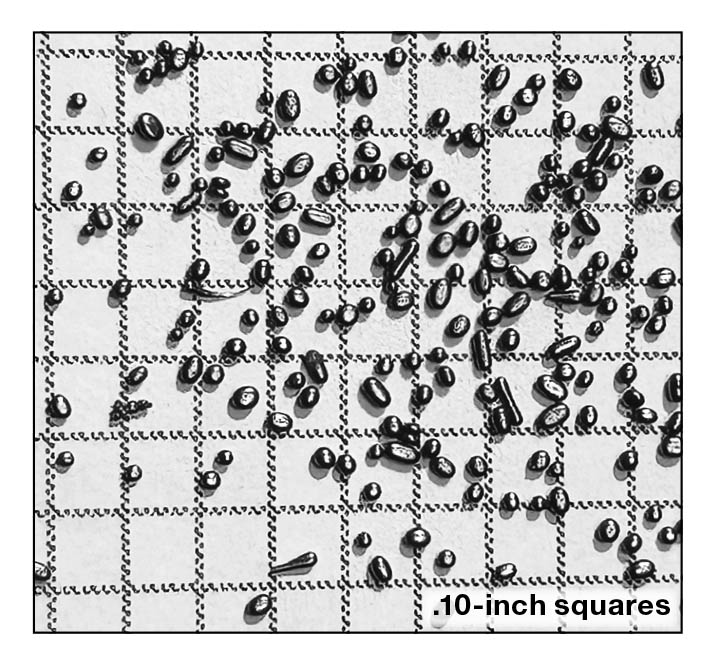Propellant Profiles
Shooters World SBR-SOCOM
column By: Rob Behr | June, 25

SBR-SOCOM’s name is a trick of clever marketing. When I first saw it, I associated SBR as an acronym for a Short Barreled Rifle. It made sense. All the data printed on the label is for the 458 SOCOM cartridge, which should have provided a clue. In this instance, SBR is an anacronym that references Southern Ballistic Research, an innovative ammunition manufacturer that was the first company to offer factory-loaded ammunition for the 458 SOCOM. Unlike most of the Shooters World line of propellants, SBR-SOCOM does not have a Lovex Powder cannister equivalent. It was created for Southern Ballistic Research by the Czech firm Explosia to provide an ideal burn rate for the 458 SOCOM.
 Physical Characteristics
Physical Characteristics

The individual powder grains are not homogeneous. The majority are either small spheres that measure somewhere around .017 inch in diameter or tubes that measure approximately .030 inch by .015 inch. Beyond that, there are individual grains that look like longer tubes and others with tapered tails. The bulk density of this double-base powder is very high at 0.99 grams/cc. This allows for very dense loads in cartridges like the 300 Blackout, which is ideal because that cartridge has very little room to spare when it comes to capacity. I also noticed something that seems very common with Shooters World propellants. The powder provides clean and accurate drops with very little static electrical cling. Ken Johnson, head ballistician for Shooters World, told me that a proprietary application of graphite to the exterior of the powder molecule is responsible for this desirable trait.
Temperature Stability Testing
The temperature at the range was 19 degrees when I began testing. The conditions were bright and clear. The first 15 shots of 300 Blackout had been frozen overnight at a temperature of -22 degrees Fahrenheit. These shots were fired methodically to keep the chamber temperature as cool as possible. The load consisted of a 110-grain Hornady V-MAX pushed by 21.0 grains of SBR-SOCOM using a Federal GM205M Match primer. It produced an average velocity of 2,251 feet per second (fps) with an extreme spread of 29.2 fps tested in an AR-15 carbine with a 16-inch Proof Research barrel. The next 15 cartridges were tested at an artificial ambient temperature of 70 degrees Fahrenheit, a feat that involved walking about 12 feet back to my warm jeep after each shot to get the next round. These cartridges produced an average velocity of 2,255 fps. The final batch had been warmed to 120 degrees and produced modestly higher velocities that averaged 2,265 fps.
I know this is not the level of testing that can be provided in a ballistics lab, but the numbers are still impressive. A shift of 142 degrees is broad and approximates the standards used by powder manufacturers to test propellants. In this instance, SBR-SOCOM saw an increase in velocity of only 0.622 percent. This is impressive for a small-grained double base powder.
Subsonic loads for a 300 Blackout are an absolute riot to shoot on the range. They are quiet enough that you can hear the buffer spring reciprocate through your shooting muffs. At longer ranges, say about 300 yards, there is a long silence, and then, if skill and luck are on your side, there is a surprisingly loud clang as the bullet rings steel. It’s addictive.
Data from the Shooters World online manual provided a pretty good starting point. With 10.6 grains of SBR-SOCOM, my 8.5-inch pistol produced 913 fps. That is definitely subsonic, but I was looking for something closer to 1,080 fps. My carbine using the same load came in at 964 fps. This isn’t a problem. There is plenty of room in the case to fine-tune the charge. The only hiccup in the whole subsonic test was that this load would not cycle with my carbine’s mid-length gas system. The pistol ran like a champ.
Aside from the 458 SOCOM and the 300 Blackout, this powder has great potential in larger handgun cartridges like the 44 Magnum, especially when used in carbines. The trick with carbines firing pistol cartridges isn’t that they are designed to withstand more pressure. It is that the barrel gives the driving gas more time to push a bullet to higher velocities. The catch is that small charges of very fast-burning powders, even at maximum pressures, produce less gas. The pressure is then lost to the increasing volume of the barrel’s length and diameter as the bullet moves toward the muzzle. This is Boyle’s Law in action and is the reason why SBR-SOCOM is such a great propellant for carbines. It offers high charge masses without exceeding maximum case pressures.
Not having a 44 Magnum lever action at my disposal, I tested it using one of the Chiappa Firearms X-Caliber adaptors in a 12-gauge barrel. Using data supplied to me as a courtesy from Shooters World, the little 7-inch adaptor produced an average of 1,368 fps with a 240-grain bullet. A standard carbine barrel would have had another nine inches to go. Think what it could have done. My hat is off to Shooters World. This is an exceptional propellant.


